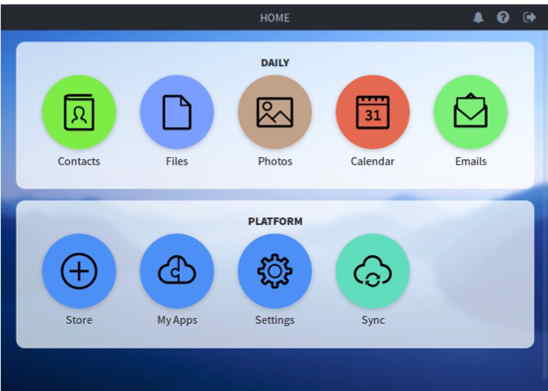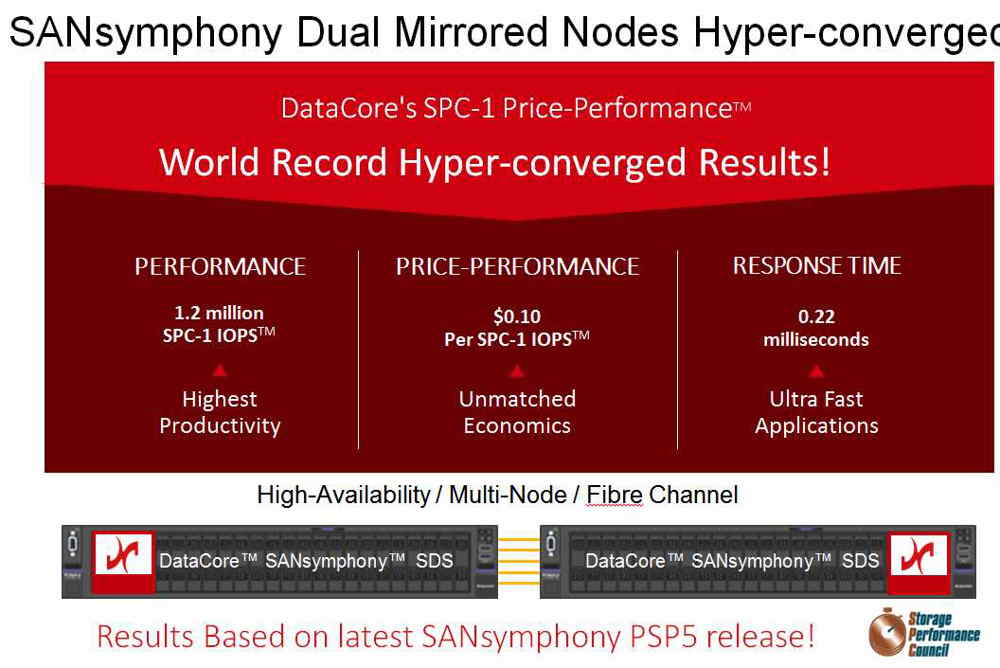DataCore Up-Scales Record-Breaking Hyper-Converged Performance With Multi-node Highly Available Server SAN
Average response time of 0.22ms, 1,201,961.83 SPC-1 IO/s, price-performance of $0.10 per SPC-1 IO/s
This is a Press Release edited by StorageNewsletter.com on June 24, 2016 at 2:59 pmDataCore Software Corporation announced record-breaking performance results for HA hyper-converged storage solutions, demonstrating the effectiveness of Parallel I/O technology in harnessing the untapped power of multi-core processors and disrupting the status quo of the storage industry.

The results are sure to send a wake-up call to a storage community obsessed with debating how to speed up latency-sensitive applications.
Using the industry’s most recognized storage benchmark for driving enterprise database workloads – the Storage Performance Council‘s SPC-1 – the company took on the classic high-end external storage arrays with a fully redundant, dual-node FC Server SAN solution, running its SANsymphony software-defined storage services Platform on a pair of off-the-shelf Intel-based servers.
“With our first SPC-1 Price-Performance record [1], we set out to prove what could be accomplished with Parallel I/O in a single server, combining the benchmark’s database workload and our storage stack in a single, atomic, hyper-converged system,” said Ziya Aral, chairman, DataCore. “Now just a few months later, we are showcasing our progress and the effectiveness of multi-node scaling.“

Near-perfect scaling and record setting response times for HA systems
Improvements to Parallel I/O performance in the SANsymphony PSP5 code used in this week’s SPC-1 HA results [2] are significant compared to the SANsymphony PSP4 code benchmarked six months ago. The earlier single node PSP4 configuration yielded an average response time of 0.32ms at 459,290.87 SPC-1 IO/s with an price-performance of $0.08 per SPC-1 IO/s [1].
Interestingly, the SANsymphony PSP5 HA configuration with two nodes synchronously mirrored over FC lowered the average response time by over 30% to 0.22ms at more than double the throughput (1,201,961.83 SPC-1 IO/s), with a price-performance of $0.10 per SPC-1 IO/s [2], securing the number three spot on the SPC-1 top ten list for price-performance [3].
“That should help to put an end to the myth that it is FC latencies that slow down SAN performance,” Aral adds. “In our experience, the opposite is true. DataCore Parallel I/O speeds up everything it touches – the fabric most assuredly included.”
Results speak for themselves
The results put SANsymphony at number five on the SPC-1 top ten list for performance [4], ranking only behind million-dollar mega-arrays including Huawei Technologies CO., Ltd. [5],Hitachi Data Systems Corporation [6], HPE XP7 [7], and Kaminario Technologies, Ltd [8], as well as DataCore’s own Paralle Server hyper-converged configuration [9]. The total price for the company’s hyper-converged HA solution was $115,142.76, including three years of support.
“We see the server SAN architecture at the intersection of the hyperscale, convergence and flash trends. Storage intelligence has been moving back adjacent to compute, and Server SANs should be deployed as a best practice to enable low latency, high bandwidth and HA in enterprise applications,” said David Floyer, CTO, Wikibon. “The move to server SAN architectures (aka hyper-converged infrastructure) has simplified operations by creating repeatable rack level deployments. DataCore with Parallel I/O software is demonstrating why these powerful multicore rack servers are becoming the basis for driving new levels of system performance and price-performance, and is a foundation for next generation system architecture.“
Aral adds, “With these new benchmark results, we up-scaled the configuration to two nodes, connected by FC fabric, and reconfigured it for full HA with mirrored everything (mass storage, cache and software). Our objective was not only to set the performance record for hyper-converged systems, but to establish the corners of our performance envelope for the purposes of sizing and configuring what is otherwise an extremely flexible Software-Defined Storage scheme.“
Unlike competitive solutions, company’s mirroring comes standard with the capability to support local and stretched/metro clusters with automatic failover and failback protection across active-active synchronized copies of data located in geographically separate locations.
Size matters: Compact server SAN for lowest TCO
In terms of lowering the TCO, it is also important to look at environmental and space considerations. Competitive storage solutions take up multiple 42U racks and many square feet of floor space, whereas the company’s configuration occupies a mere fraction (12U) of one rack.
Unlike traditional storage arrays, the firm’s nodes had the combined responsibility for running the database workloads and handling their I/O demands in the same servers – a much more challenging scenario. Firm’s Compact Server SAN solution collapses the infrastructure needed and reduces the networking and admin,rative complexity and cost. It can also be non-disruptively upgraded at any time with more powerful servers and storage technology available in the open market.
Adaptive Parallel I/O technology fully exploits power of multi-core CPUs
The response time and price-performance ratings can be mainly attributed to DataCore Adaptive Parallel I/O techniques intrinsic to the design of the SANsymphony software-defined storage services platform.
SANsymphony software availability an benchmark report details
Company’s software update has improved performance of SANsymphony and Hyper-converged Virtual SAN software solutions by up to 50%. The new software that was used as the basis for the SPC-1 benchmarking will be available in June at no charge to current customers under support contracts.
The SPC-1 performance testing is designed to demonstrate a system’s performance capabilities for business-critical enterprise workloads typically found in database and transaction processing environments. The audited configuration that was tested and priced includes SANsymphony Parallel I/O software on two standard Intel-based servers.
For complete configuration, pricing and performance details, see the SPC-1 Full Disclosure report.
[1] SPC Benchmark 1 Full Disclosure Report DataCore Software Corporation DataCore SANsymphony-V 10.0 (Current as of 11/30/2015)
[2] SPC Benchmark 1 Full Disclosure Report DataCore Software Corporation DataCore SANsymphony (Current as of 6/13/2016)
[3] SPC-1 Results – Top Ten by Price-Performance (Current as of 6/13/2016)
[4] SPC-1 Results – Top Ten by Performance (Current as of 6/13/2016)
[5] SPC Benchmark 1 Full Disclosure Report Huawei Technologies Co, Ltd. Huawei OceanStor 18800 V3 (Current as of 11/14/15)
[6] SPC Benchmark 1 Full Disclosure Report Hitachi Data Systems Corporation Hitachi Virtual Storage Platform G1000 (Current as of 2/19/2015)
[7] SPC Benchmark 1 Full Disclosure Report Hewlett-Packard Company HP XP7 Storage (Current as of 8/26/2015)
[8] SPC Benchmark 1 Full Disclosure Report Kaminario, Inc. Kaminario K2F00000700 (Current as of October 17, 2013)
[9] SPC Benchmark 1 Full Disclosure Report DataCore Software Corporation DataCore Parallel Server (Current as of 2/26/2016)













 Subscribe to our free daily newsletter
Subscribe to our free daily newsletter


